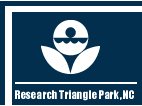



EAC Reports
Waste Stream Audit Briefing
February 7, 2000
Interim Recommendations
Establish control over purchase of computer/copier/printer paper purchase and usage. Ensure requirements of Executive Order 13101 for recycled content are met.
Paper stock of all types ordered thorough store stocks satisfies requirements for recycled content. Paper stock purchased directly via bank card is difficult if not impossible to control. Purchases via bank card should be in accordance with EPA's Comprehensive Procurement Guidelines (http://www.epa.gov/cpg/) and be a required integral part of training provided to bank card holders.
Adopt appropriate waste reductions suggestions contained in the "Waste Reduction Tip Sheet" for offices. Annual update and refresher training in the office/lab waste reduction practices is recommended.
The reductions will be incorporated into the Formal Recycling and Pollution Prevention Plan being developed for the new facility. Some of the suggested reductions are currently in practice; but, not in every building. A retraining of existing and an orientation of new employees is part of the draft plan.
Identify office/floor recycling coordinators to improve communication of programs among office staff and to serve as "watchdog" to ensure proper procedures are followed.
This would provide an excellent opportunity for members of the Environmental Advisory Committee (EAC) to either function as "watchdog" or solicit volunteers from their respective work areas. Members of the EAC are among the most environmentally conscious and would provide a valuable service as an adjunct to the Environmental Programs Manager and to the formalized recycling program in new facility.
Insure all personnel are aware of proper handling of used toner cartridges. Consider purchasing recycled toner cartridges.
An all-hands e-mail should be drafted from ?????? explaining the existing procedures for the recycling of toner cartridges. This finding was applicable to the Human Studies Facility. Programs located in other buildings were aware of the applicable procedures.
The purchase of recycled toner cartridges would require a formalized policy for store stock purchases and should be included in training for bankcard holders.
Begin preliminary discussions with NIEHS on a joint recycling program. Identify sources used by NIEHS for recycling Pyrex glass, Tyvek, etc., and establish similar relationship with vendor if appropriate.
Informal discussions have taken place with Dick Sloane of NIEHS. Verbal agreement has been reached relating specifically to Tyvek. There have been general discussions of potential coordinated efforts after occupancy of the new facility.
Laboratories should standardize chemicals used to extent possible. Efforts should be made to reduce the acquisition of lower volume chemicals through improved sharing among labs or seeking vendors who will dispense lesser quantities or custom formulate necessary reagents.
Generally speaking, chemicals are purchased in the minimum quantities required for specific experiments. There is little commonality of a specific chemical due to the range of experiments.
If not planned, a central glass/implement cleaning facility should be considered similar to that at NIEHS.
This is a viable suggestion for future consideration. Representatives of the EPA ORD Programs would need to be involved to assess the feasibility and practicality of such a coordinated effort.
Begin a coordinated removal and marketing of excess materials, equipment, records, etc., from all activities.
The Transition Steering Committee in coordination with ORD representatives and the OARM Property Office should identify those materials and equipment that can rightfully be excessed and make arrangements for the removal and subsequent auction. The OARM Building Manager should initiate a series of "clean-up events" to purge all buildings of excess paper and files to minimize initial moving costs and prohibit incurring additional post vacancy cleanup costs.
NIEHS currently ships all Styrofoam(peanuts, packing materials, etc.,) to Rhone Poulence for transshipment to a recycling company in Butner where it is converted into plastic utensils. EPA should explore this alternative after reuse opportunities have been exhausted.
This is a viable suggestion for future consideration. Styrofoam is not currently recycled and neither the quantities nor the opportunity for reuse is currently known.
Long Term:
Begin study of the practicality of establishing a central Material Recycling Facility jointly with NIEHS. Secure assistance of N. C. Office of Waste Reduction and N. C. Recycling Association in the planning process.
This is a viable suggestion for future consideration.
Establish a central HAZMAT control and tracking system for all hazardous materials used in the new facility. All hazardous materials to be transferred from existing facilities should be inventoried, bar coded, and placed under central inventory control.
ORD Health & Safety Office concurs and will address this finding.
Review energy and water conservation measures incorporated into the design of the new facility to ensure compliance with Executive Order 38561.
The Building Automation System (BAS) will be operated at optimum levels to insure the highest energy conservation levels possible, i.e. control of VAV Boxes and off hours setbacks of temperatures in office areas as well as cycling of Ahu where possible. The restroom flushing systems are automated with minimum flow rates as can be allowed to insure proper flushing of waste. A PM Program will be set up to maintain the automatic flushing system at optimum levels of operation.
Executive Order 38561, Part 2, requires reductions in greenhouse gases, energy efficiency improvement, renewable energy, water conservation and other cost- effective meausures. The baseline for calculation of progress toward these various goals is 1985 and 1990 depending on the specific goal and type of facility.
Task 5 - Construction Documents, Energy Conservation Features dated March 31, 1995 indicates that based on Department of Energy statistics, the new facility will meet or exceed energy reduction requirements.
Note: Task 5 is not a comparative analysis of projected to baseline data.
Establish an administrative procedure SOP to insure waste reduction and recycling are inherent in daily operations at the new facility.
A formal, written Recycling and Pollution Prevention Program is being developed to be implemented upon occupancy of the new facility.
Evaluate and select the best putrescible garbage, yard clippings, and other compostable waste conversion alternatives including a joint project with NIEHS.
Some form of composting will be implemented. At his juncture, the accumulation of post consumer food waste will be a requirement of the cafeteria contract. Additionally, the cafeteria contractor will be required to acquire the services of a commercial composting contractor.
Practice what we preach.
Public Law recatagorized flourescent lights as a universal hazardous waste and mandated specific treatment in terms of disposal. Bugetary constraints curtailed implementation. The management of an environmentally sustainable building will require dedicated resources in terms of consistent funding and staffing.
| EPA | RTP Campus | EAC | Search EPA |